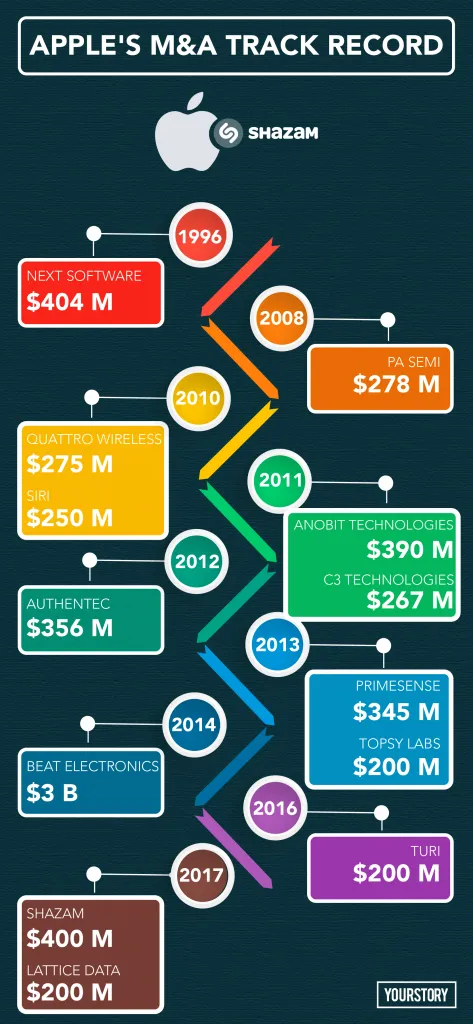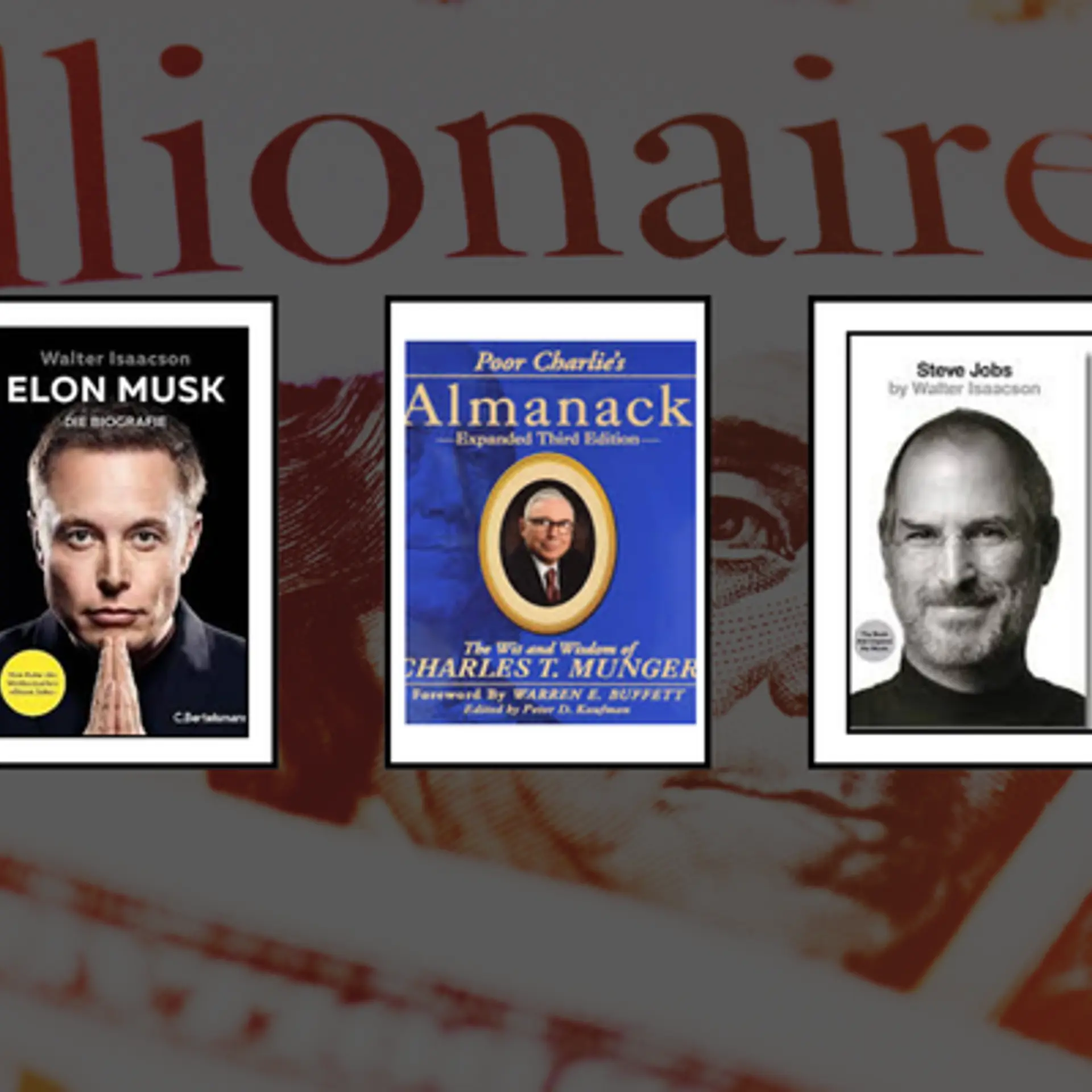Apple's top 10 acquisitions, as it acquires Shazam for a whopping $400M
The year gone by has seen plenty of activity in the mergers and acquisitions department of the global tech sector. From Cisco’s $3.7 billion AppDynamics deal to Verizon’s $4.48 billion purchase of Yahoo to Intel buying out partner Mobileye for $15.3 billion – 2017 has seen some incredible deals go down. Now finally, after weeks of rumour mills being on overdrive, Apple has confirmed the acquisition of Shazam, a British app development company, for a reported $400 million. With the purchase of the song-identifying tool, the tech giant is looking to fortify its Apple Music game, which some say has been losing ground after the emergence of Spotify.
Looking back at Apple’s past acquisition records, this present buy seems to be in sync with their overall policy of spending frugally to reinforce their own product line. In a time when global conglomerates and MNCs are throwing their financial weight around at will, Apple's approach to M&As has been more careful and cautious. After all, for a multi-billion enterprise that has repeatedly been called the world’s most valuable brand, a $400 million buy would seem like a drop in the bucket. However, the Shazam deal, Apple’s 94th acquisition so far, is pretty par for the trend. In 2017 alone, Apple made nine acquisitions, spending somewhere north of $650 million (Apple has a policy of not discussing details of its deals and purchases, so exact figures are hard to come by).
As Apple approaches its 100th acquisition sometime in 2018, we take a look at some of the tech giant’s biggest purchases and deals over the years:

Beats Electronics – $3 billion (2014)
The business world shook when news broke out that Apple shelved out a massive $3 billion to buy out Beats Electronics. The brainchild of rapper and music producer Dr Dre and record producer Jimmy Iovine, the audio product company was formed in 2006 after Dre quipped about the lacklustre quality of the pirated versions of his songs. “Man, it’s one thing that people steal my music. It’s another thing to destroy the feeling of what I’ve worked on,” recalls Iovine of Dre’s conversation.
The transaction gave Apple access to Beats Music, a subscription-based streaming service (which now lies defunct), and more importantly Beats Electronics, the audio product-development vertical which allowed the tech giant to improve its own headphones range.
Next Software – $404 million (1996)
Boy, where do we even start with this one! This news had so many angles to it that it sent the world of business into a tizzy. Next Software was one of Apple’s earliest acquisitions, and an astonishing one at that. The purchase served twin purposes. First, it marked the return of the iconic Steve Jobs – who at the time was Next’s CEO – back to his home ground Apple. Second, Apple had now found an operating system after having recently abandoned its own Copland System.
Many tech experts deem this acquisition to be the linchpin of the global tech disruption that kept changing the world of technology year-after-year and helped cast the legacy of Apple. Need we say more?
Anobit Technologies – $390 million (2011)
Anobit Technologies has been one of Apple’s biggest acquisitions in the semiconductor space. Based out of Israel, this startup was chosen for two key reasons. Its flash memory components are an important part of many of the tech giant’s products (from iPads and iPhones to MacBook Airs). To add to this, the Anobit acquisition meant that its large team of chip engineers (around 160) would be part of the Apple team.
The purchase also allowed Apple to free itself from its dependency on flash component makers such as Samsung (read, bitter rival) and Intel. Acquiring Anobit allowed Apple to leverage the chip-maker’s controller technology – a type of error correction code (ECC) – with which the tech giant is able to produce the cheapest NAND flash chip inventory for its products. Hence, this was a move which allowed Apple to kill two birds with one $390 million stone.
AuthenTec – $356 million (2012)
With the acquisition of this Florida-based company, Apple now had the one technology it was desperately looking for – a secure system that would help with data encryption, biometrics, and digital signatures, among others. Not only did the move help with the development of Apple Pay, it was also devastating for Microsoft, Google, and its other competitors.

PrimeSense – $345 million (2013)
The second Israeli acquisition by Apple, PrimeSense was one of the pioneers of 3-D sensor technology. A fabless semiconductor company, it built technology in the area of sensory inputs. The company that was once powering Microsoft’s Kinect motion-sensing system is now powering the facial recognition technology included in the iPhone X.
PA Semi – $278 million (2008)
PA Semi was Apple’s first acquisition of a semiconductor company. It was reported that Apple added the California-based chip designer company to its kitty mainly due to its interest in low-power processors, especially for mobile devices.
Quattro Wireless – $275 million (2010)
Announced in a blog post by then Quattro CEO Andy Miller, Apple’s acquisition of the mobile advertising operator was in response to rival Google’s $750 million purchase of AdMob. The company, which was founded in 2006, has an advertising network which spans mobile websites and smartphone applications. Experts believe this will help Apple monetise on the burgeoning mobile advertising platform.
C3 Technologies – $267 million (2011)
A move which was intended to bolster and up the ante in the mapping and 3D visualisation segment, Apple’s purchase of C3 Technology looked to compete with Google’s 3D satellite mapping application. Being the tech company’s third acquisition in the field of 3D mapping – after Placebase in 2009 and Poly9 in 2010 – the Swedish startup was roped in for its incredibly high-quality and detailed 3D maps created with virtually no input from humans.
Siri – $250 million (2010)
It would be hard today to imagine an iPhone without the service of its personal man Friday, Siri. Well, Apple had to dish out a mammoth (at the time) $250 million to attain full rights to the San Jose-based startup. Initially speculated as another move to supply its armament in its incessant turf war with fellow tech giant Google, the purchase paid high dividends in the following years. Siri has now become a household virtual entity, attaining a pop culture icon status.
Finishing off the list, we have three companies that were each paid a sum reported to be around $200 million.
Topsy Labs (2013)
An outright acquisition, Apple bought Topsy Labs – a real-time search engine for Twitter – to gain access to its search architecture before shutting it down in 2015.
Turi (2016)
Many in the tech world believe that Apple’s purchase of Turi helps cement the belief of AI rolling on full-steam to become an active and tangible feature of the future. The Seattle-based platform for building predictive and intelligent applications was acquired by Apple to build up its artificial intelligence capabilities.
Lattice Data (2017)
As talks grow of a future with AI soon at the helm, it’d be expected that the biggest technology player also dips its toe in the pool. Lattice Data works in the field of restructuring ‘dark data’, and has been backed by many investors, including Google Ventures, GV, Madrona, and In-Q-Tel.
It is unclear at this point what Apple’s plans for Shazam are in the future. The app already links to Apple Music; however, its algorithms can be used to improve Siri’s audio-identification capability, further improving Apple’s already powerful virtual assistant. As the war of the virtual assistants heats up with Google’s Google Assistant and Microsoft’s Cortana in the fray, and voice-enabled UI platforms becoming the norm, Apple users can hope to see improvements in the tech giant’s offerings in the future, courtesy the minds at Shazam.







